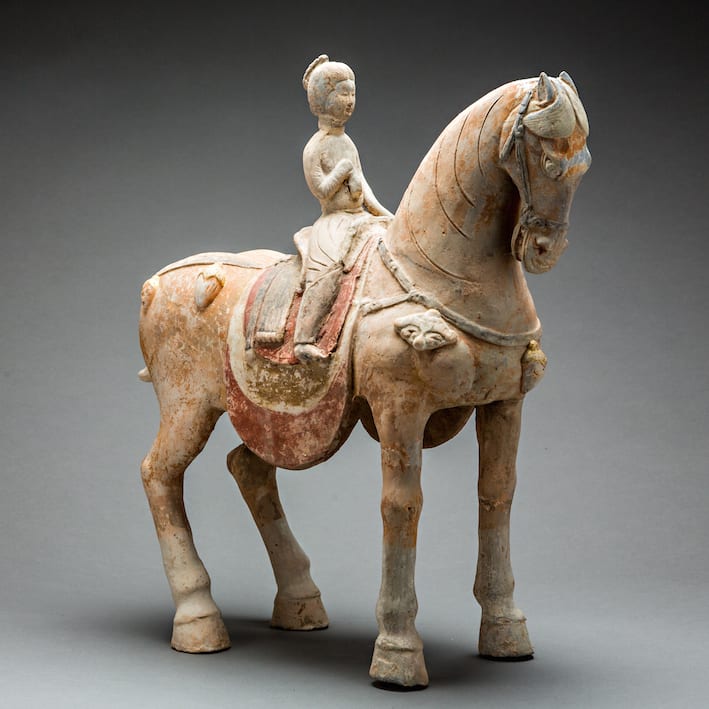Tang Painted Terracotta Sculpture of a Horse and Female Rider, 600 CE - 700 CE
Painted Terracotta
height 48.3 cm
height 19 in
height 19 in
H.686
Further images
The Tang Dynasty was an era of unrivalled wealth and luxury. The country was successfully reunified and the borders were expanded, pushing Chinese influence into new lands. Confucianism became a...
The Tang Dynasty was an era of unrivalled wealth and luxury. The country was successfully reunified and the borders were expanded, pushing Chinese influence into new lands. Confucianism became a semi-religious instrument of the state; yet Buddhism continued to flourish, spreading into Korea and Japan. The arts reached new levels of sophistication. Poetry and literature flourished under the enlightened rulers. The Silk Road brought fortunes into China. Precious treasures were imported on the backs of camels from far away lands and bartered for Chinese silk, medicinal herbs, and pungent spices. Tang China was a multicultural empire where foreign merchants from across Central Asia and the Middle East settled in the urban centers, foremost among them the thriving capital of Chang’an (modern X’ian), a bustling cosmopolitan center of over two million inhabitants. Foreign traders lived next to native artisans and both thrived. New ideas and exotic artistic forms followed alongside. The Tang Dynasty was a cultural renaissance where many of the forms and objects we now associate with China were first created. Moreover, this period represents one of the greatest cultural outpourings in human history.
The great influence of the horse throughout the history of China cannot be underestimated. In fact, the ancient expansion of the Chinese Empire was due in large part to the horse. The rapid mobility of horses allowed for quick communication between far away provinces. Likewise, the military role of horses aided in the defense of the borders from nomadic invaders as well as the conquest and submission of distant lands. The need to import stronger, faster steeds from Central Asia (as opposed to the local Mongol pony) led to the creation of the Silk Road. The importance of the horse in the history and culture of China can be viewed, in part, through the artistic legacy of this great civilization. In sculpture, painting, and literature, horses were glorified and revered. Furthermore, horses were believed to be relatives of the mythological dragon, reflecting their sacred status within society.
This general type of Chinese burial art is known as . were any of a variety of objects specifically created for interment in the tombs of elite individuals in order to provide for the afterlife. This sculpture depicts a noble lady riding upon a fine steed, inscribed on its hind leg with the Chinese characters denoting, “offical horse,” suggesting her and the horse’s elite status. Riding horses was a popular aristocratic tradition, as well as playing polo, illuminating the link between the upper crust of Tang society and horses. The early dating of this work is reflective of the stylization of the horses head and legs that were characteristic of the preceding Sui Dynasty. Overall, this sculpture is a testament to the revered status of the horse in Chinese culture, a love that reached new heights of expression during the Tang Dynasty.
The great influence of the horse throughout the history of China cannot be underestimated. In fact, the ancient expansion of the Chinese Empire was due in large part to the horse. The rapid mobility of horses allowed for quick communication between far away provinces. Likewise, the military role of horses aided in the defense of the borders from nomadic invaders as well as the conquest and submission of distant lands. The need to import stronger, faster steeds from Central Asia (as opposed to the local Mongol pony) led to the creation of the Silk Road. The importance of the horse in the history and culture of China can be viewed, in part, through the artistic legacy of this great civilization. In sculpture, painting, and literature, horses were glorified and revered. Furthermore, horses were believed to be relatives of the mythological dragon, reflecting their sacred status within society.
This general type of Chinese burial art is known as . were any of a variety of objects specifically created for interment in the tombs of elite individuals in order to provide for the afterlife. This sculpture depicts a noble lady riding upon a fine steed, inscribed on its hind leg with the Chinese characters denoting, “offical horse,” suggesting her and the horse’s elite status. Riding horses was a popular aristocratic tradition, as well as playing polo, illuminating the link between the upper crust of Tang society and horses. The early dating of this work is reflective of the stylization of the horses head and legs that were characteristic of the preceding Sui Dynasty. Overall, this sculpture is a testament to the revered status of the horse in Chinese culture, a love that reached new heights of expression during the Tang Dynasty.





